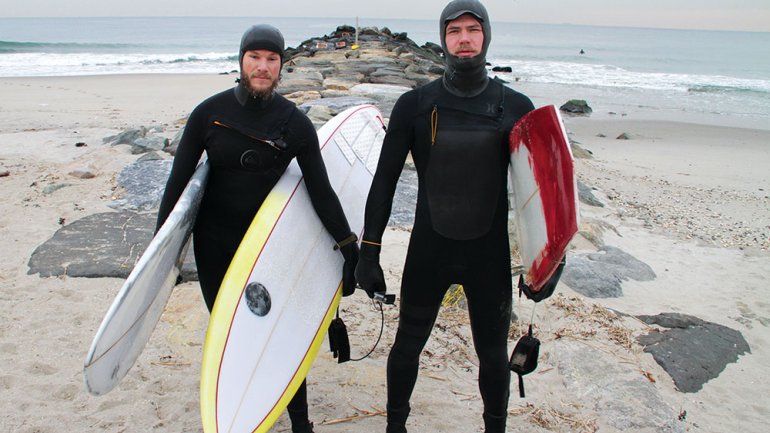Board-Certified
Board-Certified
When Michael Farley and Tyler Jorgenson went surfing together for the first time in 2013, they used borrowed boards, but they quickly decided they had to build their own. The Brooklyn duo, who met while studying architecture at the University of Arizona in Tucson, have an insatiable passion for making useful things, after years of collaborating on furniture and renovations in their spare time.
“It’s nice to have something that you shaped under your feet,” says Farley, who works as a fabricator at an architecture firm.
“We would have been defeated to buy boards off the shelf,” adds Jorgenson, who works in architecture as a project manager and was previously in the military.
The two 29-year-olds taught themselves how to make surfboards, a process that involves meticulously carving and shaping a foam blank, covering it with fiberglass cloth, and then coating it with resin, in a process called glassing. They started out making boards for themselves – they surf year-round in New Jersey and Long Island, among other places – but soon they were working for clients, charging anywhere between $500 and $1,200, the going rates for custom surfboards. Their business, which they named Wax/ Surf Co., grew through word of mouth, and in the past couple of years they’ve made hundreds of boards in various shapes and styles.
In addition to the skill required for shaping and glassing a board, there’s also a decorative component, as the two add painting, stenciling, and graphics to each board in their rented workshop space in Williamsburg. Their motifs range from geometric patterns and images of moons and astronauts to ombré color schemes and boards that look as if they were dipped in paint.
“Every board progresses our skill, and there’s such a uniqueness to it. There are infinite levels of design to express through each shape,” says Farley, who is also rebuilding a 1980s Honda motorcycle in his spare time.
They work with each client to design a board that suits the client’s skill level and the kind of waves that he or she likes to ride; they often end up surfing with their clients. It can be stressful when an experienced surfer requests a board of a precise weight – buoyancy is everything in surfing – because the shaping process isn’t an exact science. On the other hand, sometimes their clients give them great freedom in terms of design, or they come in with exciting ideas.
One client, who is now a friend, wanted a red and turquoise board, with the colors blended in an abstract, watercolor-like pattern. Farley and Jorgenson, who usually prefer stencils, straight lines, and order, were thrilled to try something new. “I’ll never forget the feeling of blending those colors, crazily and spontaneously, as if we were Picasso. The board came out looking so cool,” Jorgenson says.
Another surfer wanted an all-black longboard with two matte black stripes wrapping around the center, to match his chic, all-black beach house. The project was one of the most time-intensive that Jorgenson and Farley have taken on; they estimate it took 50 hours. “Darker boards are more difficult,” Jorgenson explains. “The glossing had to be perfect, without a single scratch. The board was so highly polished, it was like a mirror”; the matte stripes were achieved using high-grit sandpaper.
So far, making surfboards is a side gig for the two men, whose day jobs are full-time. They are in the workshop five nights a week, and on Saturdays and Sundays for anywhere between 2 and 15 hours each day. Even though they’re working nearly full-time hours on Wax/ Surf Co., they’re wary of making it their sole enterprise; for now, they enjoy not having to worry about paying their bills.
Whatever they’re working on, you won’t find them chilling out in front of the TV on any given weeknight. “Of course we want to spend time with our loved ones and our dogs,” Jorgenson says. “But building things is our humanity.”
Liz Logan is a Brooklyn freelance writer.




